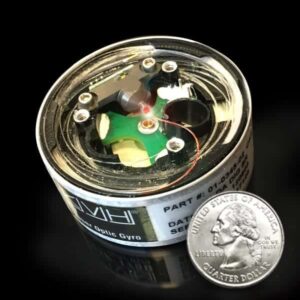 KVH Industries, Inc., a developer of sensors and integrated inertial systems, has announced that, based on its successes in autonomous vehicle prototype programs and a wide range of unmanned applications, it is developing a fiber optic gyro (FOG)-based, low-cost inertial sensor for self-driving cars. KVH has also announced that it has introduced a Developer’s Kit to support integration and testing of FOG-based inertial measurement units (IMUs) into driverless cars.
KVH Industries, Inc., a developer of sensors and integrated inertial systems, has announced that, based on its successes in autonomous vehicle prototype programs and a wide range of unmanned applications, it is developing a fiber optic gyro (FOG)-based, low-cost inertial sensor for self-driving cars. KVH has also announced that it has introduced a Developer’s Kit to support integration and testing of FOG-based inertial measurement units (IMUs) into driverless cars.
“Extremely precise heading based on fiber optic gyro technology is absolutely essential for autonomous vehicle performance. This is something we learned from having been involved with more than a dozen driverless car development programs over the years,” says Martin Kits van Heyningen, KVH’s chief executive officer. “What we are seeing now is that each driverless vehicle concept in development around the world is being designed in a unique way. With so many different possibilities, developers can accelerate their progress by working with a proven technology such as KVH’s FOGs and FOG-based IMUs and leveraging our experience to ensure their success.”
The new Developer’s Kit includes the user interface software and all components needed to immediately connect a KVH FOG or FOG-based IMU to a computer in order to configure, analyze, and test the unit. “The kit is designed to help engineers get up and running in minutes, making it easier to run diagnostics and accelerate their system development,” says Roger Ward, KVH’s director of FOG product development.
Driverless cars represent one of the fastest areas of autonomous-systems development. Transportation experts, automotive manufacturers, and engineers alike predict that driverless cars will be commonplace soon. In announcing early this year that an updated policy concerning automated vehicles will soon be published, the National Highway Traffic Safety Administration, which is part of the U.S. Department of Transportation, noted: “The rapid development of emerging automation technologies means that partially and fully automated vehicles are nearing the point at which widespread deployment is feasible.”
FOGs and FOG-based IMUs are key parts of the sensor mechanisms that are essential for highly accurate autonomous car performance. For example, FOGs provide precise azimuth measurements that an autonomous car’s logic processing unit and control systems need in order to determine motion through a curve. An IMU – which includes FOGs and accelerometers in one compact, lightweight package – does even more, providing highly accurate 6-degrees-of-freedom angular rate and acceleration data to precisely track the position and orientation of the car even when GPS is unavailable, thereby aiding the car in staying on course.
“We have successfully produced more than 90,000 fiber optic gyros for an extensive range of unmanned applications, in part because of our ability to tailor size, performance, and cost to meet different design needs,” says Jeff Brunner, KVH’s vice president for FOG operations. “Controlling the entire FOG design and manufacturing process gives us that advantage, and makes it possible to produce a low-cost sensor when driverless cars enter full-scale production.”
KVH’s FOGs and FOG-based IMUs are in use in prototype programs not only for autonomous cars, but also for production programs for underwater unmanned vehicle navigation and rail/track geometry measurement systems, to name just a few. In addition, KVH’s inertial products have been widely adopted for commercial applications such as land-based street mapping platforms, unmanned aerial systems, camera stabilization systems, and remotely operated subsea systems.
“Our IMUs and inertial sensors have already been used in a wide range of products and applications, and we know that it’s just the beginning,” says Mr. Kits van Heyningen. “We are thrilled to play a role in these exciting developments and emerging applications that are literally changing everyday life.”










